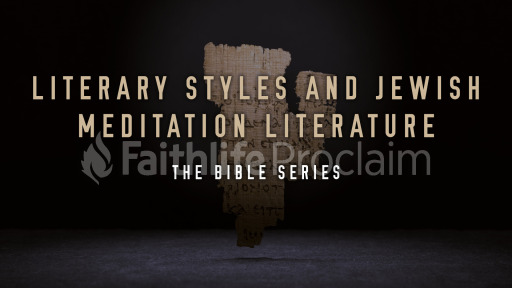Literary Styles and Jewish Meditation Literature

Notes
Transcript
Sermon Tone Analysis
A
D
F
J
S
Emotion
A
C
T
Language
O
C
E
A
E
Social
We are a couple of weeks in our new series, the Bible.
This week we're going to look at the different literary styles in the Bible. I'm pulling most of this information from The Bible Project's How to Study the Bible series, episode 3.
If you're like me and didn't pay much attention in school, this information will probably be new. Otherwise, this should be a refresher for most.
For one to wisely read the Bible, we need to be familiar with modern and ancient literary styles used by the biblical authors.
These writers expressed their ideas and claims through a variety of different type of literature. Let's explore why it's essential to identify the various literature types so we can hear their message on their terms.
Literary Styles
Literary Styles
Think of a bookstore. A bookstore is laid out with different kinds of literary styles. As you browse the aisles, you'll see many different genres of books. Some mystery, science-fiction, thrillers, biography, technical, history, poetry, non-fiction, children's books.
They all have a different purpose and style of writing. And we have different expectations from each style.
If I'm reading a book about history, I don't expect it to contain science-fiction. If I'm reading a technical book, I don't expect it to be written in poetic form.
Genre's help us identify the intent of the style. It's the same with music. If you buy an album from the country section, you'll probably expect that it doesn't feature a "boy band."
But, if you aren't familiar with the country genre, you won't know what to expect. Maybe you wanted to hear the tune of a "boy band."
Understanding the style of each book in the Bible is essential. If we don't know what we're reading, we'll miss out on what each book has to offer and is communicating.
Narrative - 43%
Poetry - 33%
Prose - 24%
Narrative
Narrative
Stories are a universal form of human communication. They have been around since the beginning of time. Stories are entertaining and are easier to remember than reciting a bunch of facts.
Through story, we can start to make sense of the random events of life, put them in a sequence to see the overall meaning of it.
The Bible is one epic narrative combined with various forms of literary styles.
A narrative always has a character. This character is on a quest or wants something. Biblical characters help us understand some of life's biggest questions.
There is always some sort of conflict that the character experiences that challenges him to discover what to do about it.
And finally, there is a resolution. Some kind of ending that wraps everything up together.
Some think that Biblical characters are there to show us how to live; an example for us to follow.
Take a look at their lives, most are deeply flawed, and we'll end up dead or in prison if we follow their example.
We're supposed to see ourselves in each character to get a different perspective about life and the choices we make.
There are many different types of narrative, including historical, parable, and biographical.
Poetry
Poetry
One out of every three chapters in the Bible is poetry.
Poems speak through a creative language to help us see the world differently.
Poems use figurative language such as simile, metaphor, personification, hyperbole, and symbolism. This type of language adds color and beauty to help express a specific point.
Although we find poetry throughout the Bible, the psalms, wisdom books, and prophets are primarily made up of poetry.
Prose
Prose
Prose is a form of language that's constructed with a natural flow of speech and ordinary grammatical structure, unlike poetry.
Prose is building a sequence of ideas or thoughts into one lateral argument that requires a logical response. It helps us think logically and consistently about a specific topic and persuades us to do something about it.
This literary style is found throughout the Torah, wisdom books, and letters from the apostles.
Primary Style
Primary Style
Before reading a book in the Bible, it important to discover the primary literary style. This will cue you into what to pay attention to and what questions to ask as you're reading.
Each book typically has a primary literary style but also has other literary types embedded throughout.
Our next literary style of the Bible is Jewish Meditation. I'll turn this over to Tim and Jon for episode 4.
Play H2R04 Video
The Bible is meant to draw its readers into a lifelong journey of reading and meditation. The Bible is designed as a multi-layered work, offering new levels of insight as you re-read it and allow each part to help you understand every other part. The Bible is the original meditation literature.